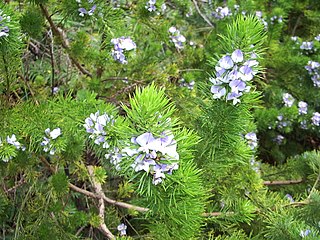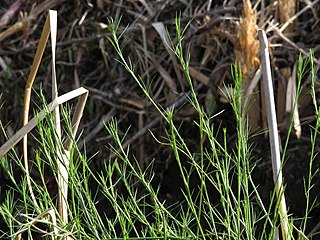
Thuja plicata is a large evergreen coniferous tree in the family Cupressaceae, native to the Pacific Northwest of North America. Its common name is western redcedar in the U.S. or western red cedar in the UK, and it is also called pacific red cedar, giant arborvitae, western arborvitae, just cedar, giant cedar, or shinglewood. It is not a true cedar of the genus Cedrus. T. plicata is the largest species in the genus Thuja, growing up to 70 metres (230 ft) tall and 7 metres (23 ft) in diameter. It mostly grows in areas that experience a mild climate with plentiful rainfall, although it is sometimes present in drier areas on sites where water is available year-round, such as wet valley bottoms and mountain streamsides. The species is shade-tolerant and able to establish in forest understories and is thus considered a climax species. It is a very long-lived tree, with some specimens reaching ages of well over 1,000 years.

Psoralea is a genus in the legume family (Fabaceae) with 111 species of shrubs, trees, and herbs native to southern and eastern Africa, ranging from Kenya to South Africa. In South Africa they are commonly referred to as fountainbush (English); fonteinbos, bloukeur, or penwortel (Afrikaans); and umHlonishwa (Zulu).

The Joinvilleaceae are a family of flowering plants with a single genus including four species. The APG II system, of 2003 assigns it to the order Poales in the clade commelinids in the monocots. The family consists of one genus with four currently accepted species, distributed from the Malay Peninsula to the Caroline Islands and high islands in the Pacific Ocean. It is evolutionarily significant as a relictual group closely related to grasses. They closely resemble large grass plants, in both general appearance and microanatomy, but possess fleshy fruits.

The gray sac-winged bat is a species in the family Emballonuridae which comprises the 51 species of sac-winged bats. It is found in Mexico from Baja California Sur and Sonora to Guatemala, El Salvador, Honduras, Nicaragua, Costa Rica and northern Colombia, at elevations up to 1,500 metres (4,900 ft).

Psoralea arborea is a species of legume in the family Fabaceae. It is a shrub or tree endemic to the Cape Provinces of South Africa.

Psoralea pinnata is an erect evergreen shrub or small tree that grows to a height between 1.5 metres (5 ft) and 4 metres (13 ft) tall.

Spathoglottis plicata, commonly known as the Philippine ground orchid, or large purple orchid is an evergreen, terrestrial plant with crowded pseudobulbs, three or four large, pleated leaves and up to forty resupinate, pink to purple flowers. It is found from tropical and subtropical Asia to Australia and the western Pacific including Tonga and Samoa.

Plicadin is a coumestan found in the herb Psoralea plicata.
Cullen plicatum, synonym Psoralea plicata, is a herb species in the genus Psoralea. It is native from northern Africa to north-west India and to South Africa.

Plicatula is a genus of saltwater clams, marine bivalve molluscs, known commonly as kitten's paws or kittenpaws in the family Plicatulidae.
The pars plicata is the folded and most anterior portion of the ciliary body of an eye. The ciliary body is a part of the uvea, one of the three layers that comprise the eye. The pars plicata is located anterior to the pars plana portion of the ciliary body, and posterior to the iris. The lens zonules that are used to control accommodation are attached to the pars plana.

Plicatin B is a hydroxycinnamic acid found in Psoralea plicata.

Bakuchiol is a meroterpenoid in the class terpenophenol.

Psoralidin is a natural phenolic compound found in the seeds of Psoralea corylifolia.

Drupanol is a naturally occurring phenol that has been isolated from the seeds of Psoralea drupaceae. Although drupanol is sometimes said to be the same compound as bakuchiol, the two compounds are in fact distinct; they have the same molecular formula and weight but different chemical structures and hence are structural isomers. Bakuchiol has been found to possess antiandrogenic activity in vitro.

Psoralea fascicularis, the large-stipule fountainbush, is a species in the pea or Fabaceae family. It is endemic to the Western Cape province of South Africa where it has been red listed as endangered (EN) by the International Union for Conservation of Nature (IUCN) Red List of Threatened Species due to its declining population.

Psoralea cataracta is a species of flowering plant in the family Fabaceae. It was declared extinct in 2008 in the Red List of South African Plants, with a single specimen collected from the Tulbagh Waterfall in 1804. It was rediscovered 200 years later by Brian Du Preez in November of 2019 in the Winterhoek Mountains near Tulbagh. It is endemic to the Western Cape. It is also known by the name waterfall fountainbush.















